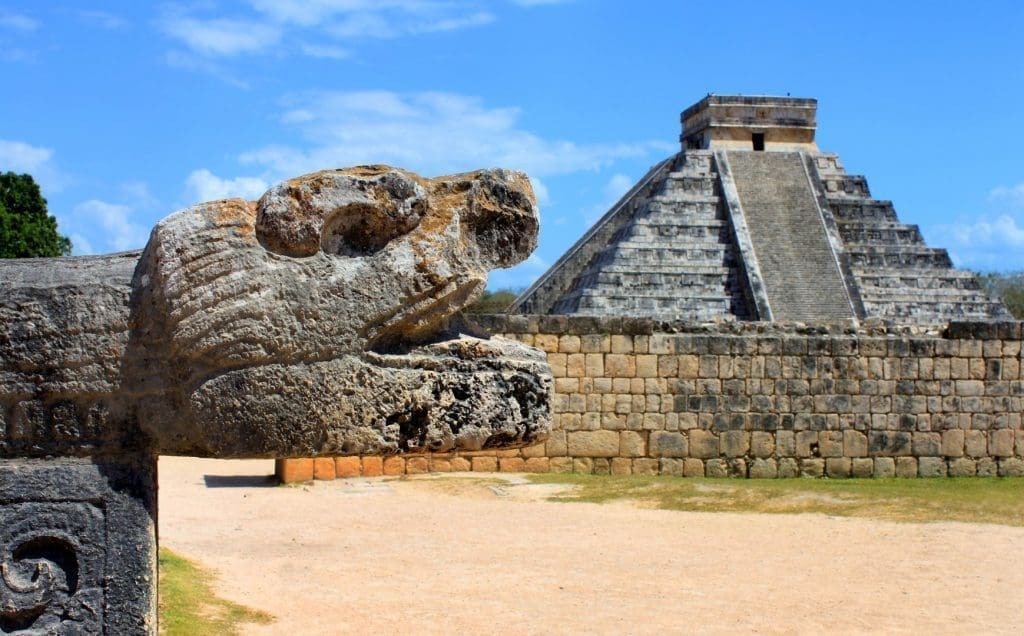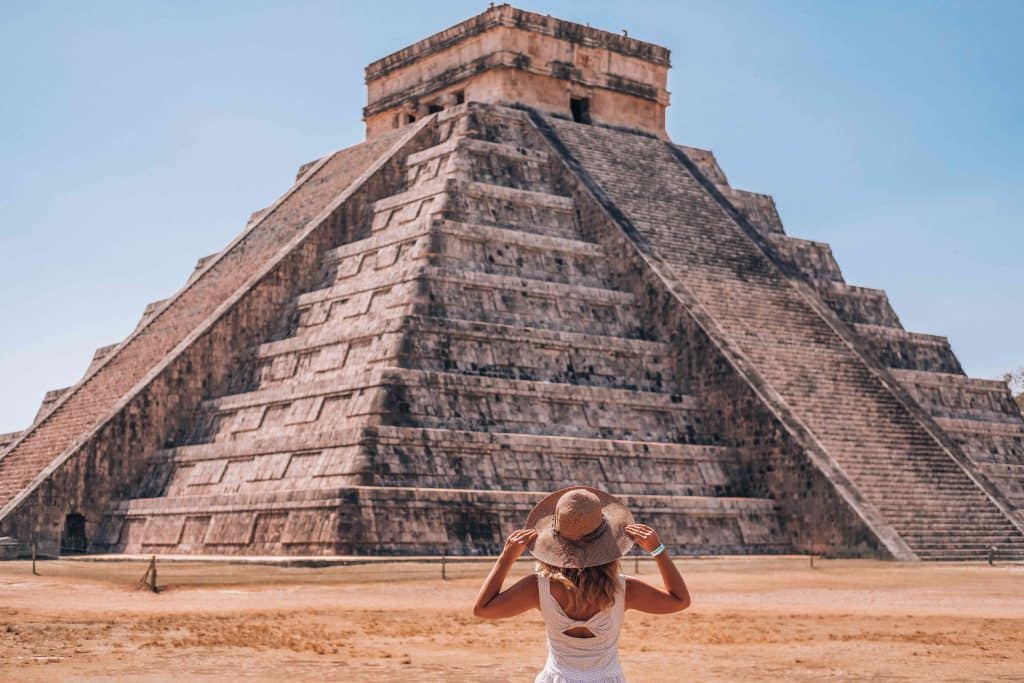The Secret of Chichen Itza: Spring Equinox Awakens 10-Story Serpent
Do you remember that part in the first Indiana Jones movie where he puts the staff in the ground and waits for the sun’s light to pass through it at a specific time to reveal the location of the Ark of the Covenant?
Well, that was fiction, but at the archaeological site of Chichen Itza in Mexico, you can witness a natural astrological phenomenon that Mayan architects purposefully designed when they built El Castillo sometime between 900 and 1,200 years ago. The ‘Descent of Kukulcán,’ also known as the feathered serpent! The serpent descends the steps of the Kukulcán Pyramid, which is also called El Castillo. The phenomenon happens during the spring and fall equinoxes, which in 2022 will be on March 20 and September 22. The action begins at 3:45 in the afternoon, and it is visible for a few days before and after each equinox. On your self-guided Chichen Itza tour, you can learn all about the site and witness this incredible event!
 Chichen Itza – Serpent
Chichen Itza – Serpent
The Story of Kukulcán
The story of the feathered serpent began when Toltecs invaded the Mayan Peninsula. The people living there, the Itzaes, were not prepared for war, and the Toltecs could occupy their city with little resistance.
The Toltecs had come to this region because they believed they followed their god, Quetzalcoatl. It didn’t take long before the Mayan people adopted him as their god too, but they called him Kukulcán
To show just how powerful Kukulcán was, the Toltecs gathered thousands of people from all over the Mayan Peninsula on the days of the equinox to witness their grand god descending to Earth to speak to them.
One can only imagine the awe they felt as they witnessed the serpent descending the steps of the Pyramid of Kukulcán. This event was likely accompanied by incredible sound effects due to the intentionally designed acoustics of the pyramid. You have to check it out for yourself to see just how impressive it must have been.
The Design of the Kukulcán Pyramid
You see, the Mayan architects knew all about astronomical events. Using that knowledge, they were able to determine the exact placement of the pyramid to create the effect of the descent of the 10-story serpent. They were good architects because they knew how to make a lasting impression. They used the design of the stairs to create shadows that form the shape of the serpent’s body, the head of which was sculpted at the foot of the staircase so it would be in line with the descending body.
 Chichen Itza – Self-Guided Tour
Chichen Itza – Self-Guided Tour
The pyramid itself is called a step pyramid. It is a total of 99 feet high (30 meters), and it consists of several square terraces with stairways that run up the four sides to a temple that sits on top.
The stairways consist of 91 steps on each side, and when added together with the temple platform as the final step, there are a total of 365 steps, the number of days in the Mayan Haab’ year. It’s a veritable masterpiece of architectural design!
With a base of almost 175 feet (53.3 meters) wide on all four sides, this is an enormous pyramid at the site of Chichen Itza. It’s an incredible achievement and one that you won’t want to miss a chance to visit. Action Tour Guide can help with that!
There’s more too! The nine stages of the pyramid–which are bisected by stairs on each side–represent the 18 months in the Mayan calendar year. Archaeologists believe that it was built as a physical representation of that calendar. You might remember that many people predicted the end of the world in 2012 because of that calendar.
In reality, the Mayan calendar starts anew at the end of the cycle. It wasn’t predicting that the world would end (it’s good for us, it didn’t); simply that a new cycle would start.
The pyramid is also aligned at a point of intersection between four cenotes–the Sacred Cenote is to the north, Xtoloc is to the south, Kanjiyum is to the east, and Holtún is to the west. These are all part of the Action Tour Guide self-guided tour as well.
The eastern and western sides of the temple are angled, aligning with the sunset and sunrise. This alignment corresponds with actual calendar events such as harvesting or planting (kind of like an ancient, massive, and complicated palm pilot). It provides a link to other Mesoamerican sites of importance. This pyramid has got it all!
The design and importance of this pyramid at Chichen Itza led to the designation of this Mayan archaeological site as a UNESCO World Heritage Site.
The Descent of Kukulcán
Around 3:45 in the afternoon of the Spring Equinox on March 21, 2021, you can witness the descent of Kukulcán. As the sun continues on its path, you’ll see the body of the serpent moving down the steps until such a time as all of the steps of the pyramid are covered in shadow, with only the head of the snake still bathed in sunlight. Eventually, it too will be covered in shadow.
This is an event that thousands of people have witnessed for hundreds of years, and it continues to draw crowds to this day. Talk about a bucket list item!
The site is one of the most widely recognized and visited Mayan archaeological sites in Mexico. Still, it’s not the only thing to enjoy while visiting this critical site, and Action Tour Guide’s self-guided tour can help you enjoy it all!
Related Post
The entire tomb is filled with signs and symbols that mention Queen Nefertiti and after some time passed and linguistic experts managed to decipher the stories told here, the team was baffled.
The mystery of the Solar Temple of Abu Gurab and its “Star Gate” comes to light
Thuya, the mother of Queen Tiye, left a monumental legacy by becoming the grandmother of Akhenaten and Tutankhamun.
The oldest traditions lead us to believe that blacks were the first inhabitants of Mexico.
The REAL face of King Tut: The pharaoh had feminine hips, clubfoot, and protruding teeth according to the ‘virtual autopsy,’ which also revealed that his parents were brother and sister.
The “oldest gold of humanity” was found in the Varna necropolis, on the Bulgarian Black Sea coast
